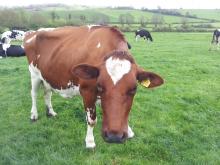As the weather starts to warm up, hopefully, now is the time to start thinking about preparing for turnout.
To ensure everything gets sorted, four key points should be considered:B
- Biosecurity – Fencing, tracks, gateways and water supplies
- Parasite control – Correct use of anthelmintics and vaccination
- Disease control – Vaccination
- Nutrition and Mineral Supply
Biosecurity
Good fencing obviously avoids the annoyance of animals escaping and the financial implications of damage to third party property, but mixing with neighbouring stock also increases the risk of introducing diseases such as BVD or IBR.
Remember, given the choice, cattle prefer to walk down tracks in single file at their own pace, avoiding stones, so an improved area does not need to be that wide. Concrete railway sleepers or thick rubber belting can help provide a more comfortable surface and reduce the incidence of lameness.
It is important to check water pipes and troughs for leaks and to ensure troughs are filling properly. If stock are to get their water from natural sources, consider whether this increases the risks of diseases such as Liver Fluke or Lepto and ideally fence these areas off and provide water from the mains.
Parasite Control
Liver Fluke: If fluke treatment is required prior to turnout, use a product that will only kill adult fluke to reduce egg output onto pasture. This is important to reduce resistance to other products that kill immature fluke which are best to use in late summer/autumn.
Cattle: Dosing of adult cattle is usually unnecessary and likewise, calves born and raised indoors are usually worm-free at turnout and should not require worming at this stage. The exception would be if a high level of pasture infection and risk of disease is anticipated, when a product with persistent activity can prevent both disease and further pasture contamination. If lungworm is a problem on your farm, vaccinating youngstock prior to their first grazing season is an important control strategy. Two oral doses should be given 4 weeks apart, with the second dose 2 weeks before turnout. The vaccine relies on exposure to lungworm for its efficacy, therefore use of wormers should be avoided for several weeks around vaccination.
Sheep: Dosing ewes at turnout for parasitic worms needs to be a compromise between reducing pasture contamination for lambs and avoiding resistance and is affected by the change in immunity due to pregnancy. Discuss with your vet and use SCOPS principles to develop a strategy for your farm.
Disease Control
It is important to ensure your herd is up to date with its protection against Leptospirosis, BVD and IBR prior to turnout.
Nutrition and Minerals
If pastures/soils are known to cause mineral deficiencies, which may affect growth rates or have effects on fertility, then treating your animals with long acting boluses before turnout will provide the minerals they need. However, caution must be taken as poisoning can occur with some minerals.
Grass staggers (Hypomagnesaemia): Rapidly growing spring grass is often low in magnesium. Grass that has been fertilised with potassium containing fertilisers or slurry has less magnesium available and also lush grass tends to pass through animals quickly, reducing magnesium absorption. Therefore, pasture management is the mainstay of prevention, along with supplementation of concentrates containing magnesium and/or hay/silage.
Check out our latest Farm Skills Courses . Alternatively call and speak to a member of the Farm Team on 01363 772860 or email to discuss your training needs.
Written by Danielle Priestley MRCVS.


